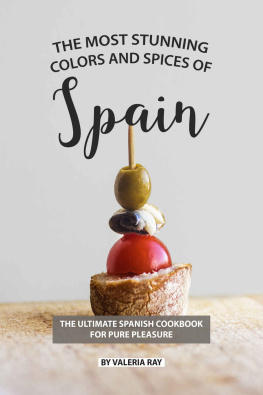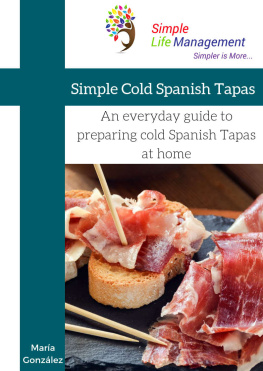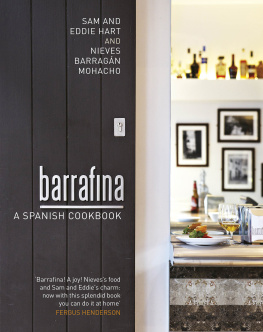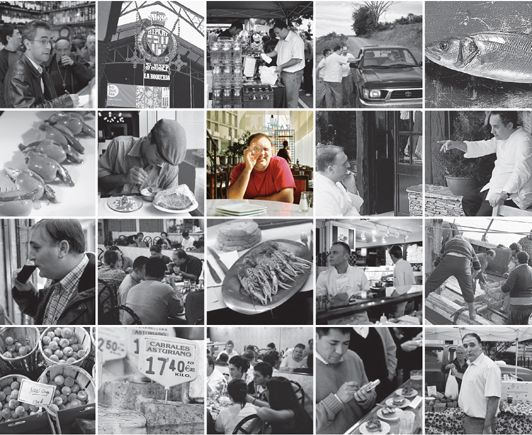
Copyright; 2005 by Jos Andrs
All rights reserved.
Published in the United States by Clarkson Potter/Publishers, an imprint of the Crown Publishing Group, a division of Random House, Inc., New York.
www.clarksonpotter.com
CLARKSON N. POTTER is a trademark and POTTER and colophon are registered trademarks of Random House, Inc.
Library of Congress Cataloging-in-Publication Data
Andrs, Jos,
Tapas: a taste of Spain in America / Jos Andrs; with Richard Wolffe.
1st ed. Includes bibliographical references and index. 1. TapasUnited
States. 2. Cookery, Spanish. I. Wolffe, Richard. II. Title.
TX740.A6854 2005
641.812-dc22 2004027466
eISBN: 978-0-7704-3423-6
Photographs by Francesc Guillamet
Art Direction by Roberto Sablayrolles
Front cover photograph: Wyatt Counts
Design by Tasty Concepts
v3.1
Contents
contenido
Introduction
How to Use Tapas
Chapter 1

Olives and olive oil
Aceitunas y aceite de oliva
Chapter 2

Tomatoes
Tomates
Chapter 3

Potatoes
Patatas
Chapter 4

Mushrooms
Setas
Chapter 5

Legumes
Legumbres
Chapter 6

Peppers
Pimientos
Chapter 7

Vegetables and more
Verduras y ms
Chapter 8

Citrus
Ctricos
Chapter 9

Garlic and onions
Ajo y cebollas
Chapter 10

Rice
Arroz
Chapter 11

Cheese and eggs
Queso y huevos
Chapter 12

Fish
Pescado
Chapter 13

Shellfish
Mariscos
Chapter 14

Chicken
Pollo
Chapter 15

Pork
Cerdo
Chapter 16

Other meats
Otras carnes
Preface
prefacio
I arrived on these shores twelve years ago as a young Spaniard who thought he knew it all. What I discovered was not the end of my journey, but the start of one. For the last decade and more, Ive been searching inside myself for the meaning of Spanish cooking. Searching for the traditional cooking I grew up with, and adore, and live for. To me, its so much more than work or what pays my salary. Its a way of life. I smell, I breathe, I think, I dream of cookingand, more often than not, of Spanish cooking. As Ive traveled across America, Ive learned so much about this countrys cooking and so much more about my own countrys cooking. Im absorbed by the search for what happened through the centuriesthe different cultures, religions, and peoples that shaped Spanish cooking into what it is today. It was only by exploring the New World that I could see the real nature of the Old.
Every night at my tapas restaurants, we try to bring the culture and the flavors of Spain to America. Yet for me, something else happened while I was re-creating the best of my country: by bringing Spanish cooking to America, I discovered how to combine traditional Spanish dishes with the amazing ingredients and bounty of this extraordinary country. I dont import fish from Spain for all our dishes (sometimes it even comes from the Pacific Ocean). But that doesnt mean that my Spanish cooking is any less traditional or less authentic in America. On the contrary: it becomes richer by adapting its spirit to the flesh of the local ingredients. I could spend days telling you how great things are in Spain: the fish, the meat, the soul of the country. But after spending half my adult life in the United States, I have grown into a unique hybrid, combining the best traditions I learned at home with the open-minded approach that lies at the heart of America.
My first contact with the United States was as a young sailor in the Spanish navy, visiting Pensacola, Norfolk, and New York. I thought at the time that I had accomplished my childhood dream of visiting the United States. But somewhere on that trip, something inside me told me Id be coming back. A few months later, after returning to Spain, I finished my military service and flew back to New Yorkthis time as a cocinero , or cook. All I had was a small bag on my back, a couple of chefs coats, a little money, and a big dream of conquering America with Spanish cooking. I was also lucky enough to have a job at two restaurants: El Dorado Petit and Paradis Barcelona. El Dorado Petit was one of the best restaurants in Spain, and it was trying to sell New York its version of Catalan cooking. Unfortunately, neither restaurant made it.
Even though they lost a lot of money, those restaurants did an amazing job of trying to refresh what Spanish restaurants should be (and showed me, as a young chef, some critical mistakes). During my time in New York, one person who influenced me more than anyone else was Clemente Bocos, at El Cid in lower Manhattan, an amazing little tapas place. Clemente became like a father to me, with a ready phrase to guide me and a deep interest in my future. One very cold night, while we were sharing the most wonderful garlic soup and I was venting my frustrations about the restaurants, Clemente gave me a very wise piece of advice: Jos, he said, no matter what you do, dont try to reinvent Spanish cooking in America. Dont try to guess what Americans would like to eat. Cook what you remember from Spain. Dont listen to people who say, They wont like this or that. If you stick to the basics, and execute them well, people will like your cooking, and they will like Spanish food.
That was just before I was contacted by my current partners and friends, Roberto lvarez and Rob Wilder, who told me they wanted to open a tapas place in Washington, D.C., and needed a Spanish chef. They gave me the restaurants, and I gave them my expertise, my ideas, and my spirit. The lessons Id learned in New York proved invaluable in creating Jaleoa catchy name for a Spanish restaurant, named after the John Singer Sargent painting of a flamenco party. Eleven years later, the woman at the heart of this classic painting now dances on the walls of three Jaleos, each serving 5,000 people a week.


























